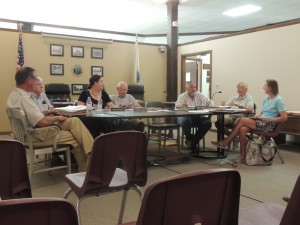A letter dated July 16, 2015 from G.A.F. Engineering and addressed to the Marion Board of Selectmen about the withdrawal of seven acres of Chapter 61A agricultural/horticultural use land for the purpose of a solar farm prompted a new line of questioning from the Marion Planning Board on the first night of public hearings for the proposed Tucker Lane solar farm.
The board asked the project’s engineer, Bob Rogers, to present more detailed site plans reflecting the July 16 withdrawal of some, but not all, of the land from Chapter 61A status.
“You have created a smaller lot within a legal lot and only the smaller lot matters,” Chairman Robert Lane told Rogers.
Lane hoped that Rogers could confirm that the existing plans will meet the dimensional requirements of the acreage that was taken out of 61A, but Rogers – at first confused at what was being asked – will require time to sit down with the landowners and project developers to consider the board’s assertion that once the seven acres is withdrawn from Chapter 61A use, the land requirements of the project might change.
Clean Energy Collective’s two representatives, present at the public hearing, assured the board that the plans would be updated to reflect the 61A changes in preparation for the board’s next meeting, which is also the public hearing’s continuance.
“The important thing is, what you have elected to remove from 61A is [now] what you have to work with,” Lane instructed. “It’s a lot for dimensional and development purposes … hopefully it’s just a clerical and administrative issue that you can work on.”
Despite the confusion caused by the July 16 letter, the board was pleased with the site plans.
“It is incumbent on us to be thorough and careful throughout the process,” Lane said at the start of the hearing, assuring Marion residents that the board would practice due diligence for what will be the first solar farm proposed under the new solar bylaw.
Rogers expressed his own favor for proceeding slowly.
“From our perspective, G.A.F.’s perspective, it’s good to have a full public hearing with Planning Board and a full public hearing with Conservation Commission.” Rogers is also working with the Rochester Planning Board as part of the project – the construction of the gravel access road – falls within Rochester’s borders.
In his presentation, Rogers said that there are not many moving parts to the project: a chain link fence, a gravel access road, the solar panel array, and the limits of tree clearing.
“The only thing that requires some engineering is the drainage design,” Rogers said. “There are no community impacts associated with traffic and schools,” he concluded.
Many Marion residents expressed initial concern about the proposed tree clearing, but Rogers was quick to ease any worries. First, he pointed out that the tree clearing is minimal – only enough to allow construction for the drainage basin and to clear paths for the access road and electrical wires.
“Any trees under 20 feet stay; any larger are cut down with the stumps left,” Rogers said. Second, the intent is to keep the clearing natural. Maintenance of the property will also keep the property – an existing hay field – natural.
“It will be maintained to the point of preventing growth in the space between panels,” Rogers said. “There will be periodic weed whacking, if you will.”
Comments from the board members were largely positive.
“I’m looking forward to the process; I’m looking forward to how the bylaw is going to handle this,” board member Steve Gonsalves said.
“It’s all very good, it just has to be done in the right way to protect the citizens,” board member Dr. Michael Popitz said.
Marion residents, largely residents of the Tucker Lane neighborhood who will abut the proposed solar farm, expressed concerns about their property values, the visibility of the solar farm from their homes, the sufficiency of the $39,000 placed in escrow in the event that the solar farm is decommissioned, and the general impact that the solar farm will have on their homes.
Lane was quick to encourage residents to participate in every stage of the process, especially given that many residents are just learning about the project and will require more time to digest information and develop questions for the civil engineers and project manager.
“I think you and your neighbors should do what you feel is appropriate to protect yourselves,” Lane said.
“Go read the bylaws and see what your protection is,” board member Rico Ferrari recommended.
Board member Norman Hills also offered concerned residents advice.
“You should participate in these meetings and listen to the engineers resolve these questions before you jump to conclusions,” he said.
To that end, the team of Clean Energy Collective and G.A.F. Engineering announced that there is an initial public hearing for the project with the Rochester Planning Board on July 28 at 7:00 pm. The public hearing with the Marion Planning Board will be continued at the board’s next meeting on August 3 at 7:15 pm. There is also an opportunity to learn about the project at the Marion Conservation Commission’s meeting on July 22 at 7:00 pm, although this is not a public hearing.
By Anne Smith
